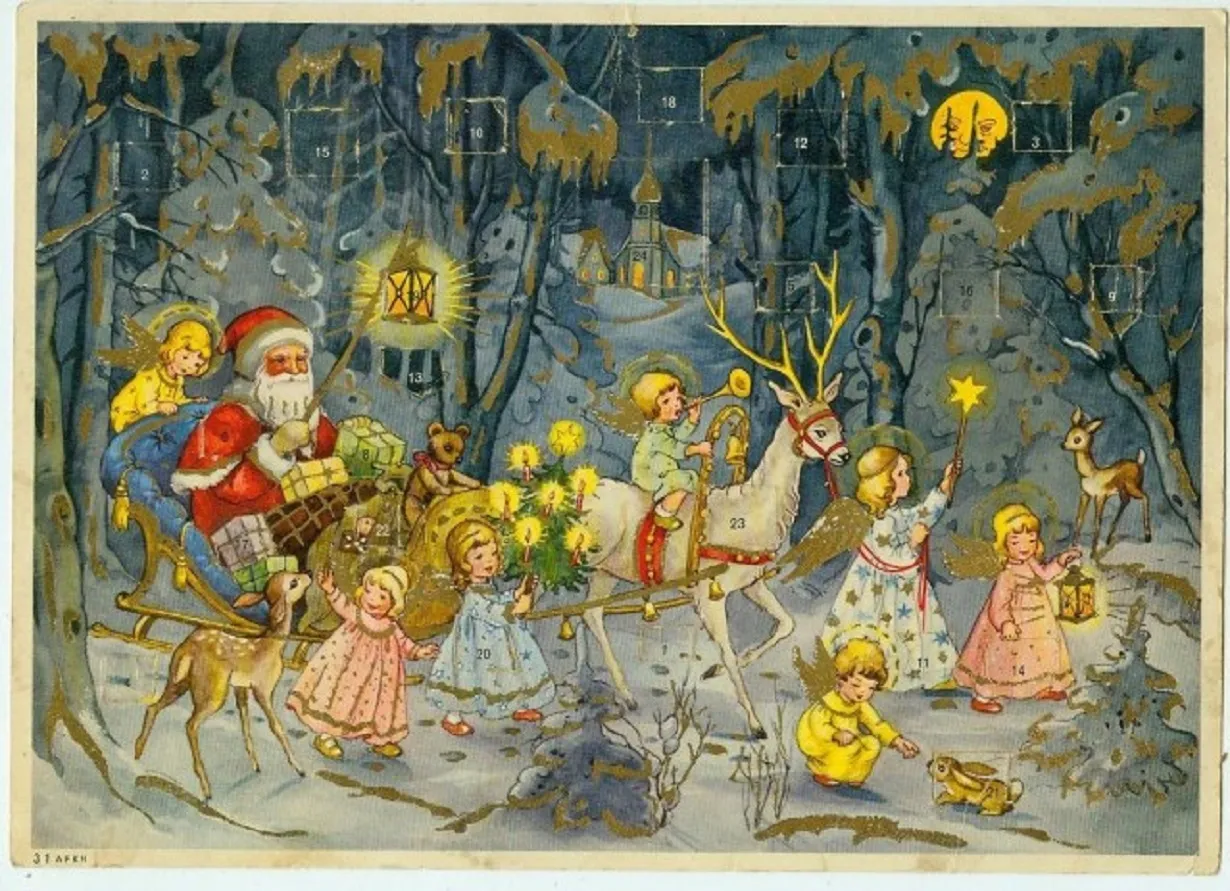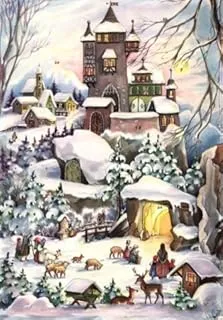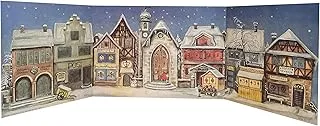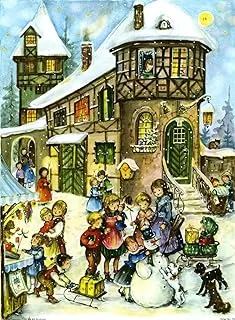
The German Advent Calendar Tradition: A Complete Guide to Germany's Most Beloved Christmas Custom
The advent calendar tradition in Germany represents one of the most enchanting and deeply rooted Christmas customs that has captivated families for over 150 years. As someone who has experienced the magic of opening those tiny doors each December morning, I can attest to the profound cultural significance this tradition holds in German households. From its humble 19th-century origins to today's elaborate chocolate-filled calendars, this beloved practice continues to build anticipation and joy during the Christmas season. Visit Nature Guests for more traditional German holiday insights.
The Historical Origins of German Advent Calendars

The advent calendar tradition in Germany has its roots deeply embedded in 19th-century Protestant culture, where families sought creative ways to mark the days leading up to Christmas. The earliest documented advent calendar dates back to 1851, mentioned in a children's book by Elise Averdieck, though the practice likely existed in various forms before this official recognition.
The story that captures my heart every time involves a young boy named Gerhard Lang in the 1880s, whose impatient anticipation for Christmas prompted his mother to create something truly special. She crafted small boxes filled with Lebkuchen (traditional German gingerbread cookies), allowing Gerhard to open one each day during Advent. This maternal ingenuity would later inspire the commercial advent calendar industry when Lang grew up to become a publisher.
By 1902, the first printed "Christmas Clock" appeared in Hamburg, featuring a moveable dial that counted down the days like a traditional timepiece. This innovation marked the beginning of mass-produced advent calendars that would soon spread throughout German-speaking regions and beyond.
Historical Insight: The tradition reflects the German concept of "Vorfreude" - the joy of anticipation - which is considered as important as the actual celebration itself.
The commercialization of advent calendars gained momentum in 1908 when Gerhard Lang, now working at Reichhold & Lang publishing house in Munich, began producing his memorable calendars. These early versions consisted of a main cardboard section divided into 24 squares, each containing a verse, accompanied by a separate sheet of colorful images that children could cut out and glue onto the appropriate squares.
The innovation of doors that could be opened came in the 1920s, revolutionizing the advent calendar tradition in Germany. This development added an element of surprise and discovery that enhanced the anticipation children felt each morning. The practice became so popular that by the 1930s, advent calendars had transcended national boundaries, reaching Great Britain and the United States.
Interestingly, the Nazi regime attempted to secularize this cherished tradition during World War II, banning the printing of religious-themed calendars and replacing Christian imagery with Germanic symbols and fairytale figures. However, this dark period couldn't diminish the fundamental appeal of the tradition, and after the war, advent calendars returned stronger than ever, with chocolate-filled versions appearing in the 1950s.
Cultural Significance and Religious Roots
The advent calendar tradition in Germany serves as more than mere countdown mechanism; it embodies the deeply spiritual concept of Advent itself, derived from the Latin word "adventus," meaning "arrival" or "coming." This four-week period of preparation, anticipation, and reflection has been observed by Christian churches since the 4th century, making advent calendars a tangible connection to centuries of religious tradition.
In German households, advent calendars complement other cherished Christmas customs, including the Adventskranz (Advent wreath) with its four candles, and the weekly Adventsstunde (Advent hour) when families gather to sing carols and songs around the flickering candlelight. These traditions work together to create what Germans call "Weihnachtsstimmung" - the magical Christmas atmosphere.
The cultural importance extends beyond religious observance into the realm of family bonding and childhood development. German parents have long recognized that advent calendars teach children patience, the value of anticipation, and the concept that some of life's greatest joys come to those who wait. This aligns perfectly with the German cultural emphasis on delayed gratification and mindful celebration.
The tradition also reflects Germany's unique approach to Christmas celebrations, where the focus remains on Heiligabend (Christmas Eve) rather than Christmas Day. This timing makes the advent calendar's culmination on December 24th particularly meaningful, as families gather for their most important celebration of the year, often including visits to Christmas markets and participation in St. Nicholas Day celebrations.
Modern German families often create their own advent calendars, filling small bags or boxes with homemade treats, small toys, or notes with daily activities. This DIY approach maintains the personal touch that characterized the earliest advent calendars while allowing families to incorporate their own values and traditions into the practice.
Cultural Note: Germans don't typically say "Merry Christmas" before December 24th. Instead, they wish each other "Schöne Adventszeit" (Beautiful Advent time), emphasizing the importance of the entire preparation period.
Traditional Types of German Advent Calendars

The diversity of advent calendars reflects the rich regional variations found throughout Germany, each type serving different purposes while maintaining the core essence of the advent calendar tradition in Germany. Understanding these varieties helps appreciate the depth and adaptability of this beloved custom.
Traditional Paper Calendars
The classic paper advent calendar, often called "Adventskalender," features beautiful lithographed images depicting winter scenes, nativity stories, or cozy German villages. These calendars typically measure about 16 by 12 inches and are constructed from sturdy cardboard with perforated doors that can be carefully opened to reveal small pictures or verses behind each numbered compartment.
What makes these calendars particularly special is their artistic quality. Many feature glitter accents, embossed details, and intricate illustrations that transform them into temporary works of art displayed prominently in German homes. The imagery often includes traditional German architecture, snow-covered landscapes, and scenes from nativity scenes that reflect the country's Christian heritage.
Chocolate-Filled Calendars
The evolution toward chocolate advent calendars began in the 1950s, introducing a sweet element that enhanced the daily surprise. These calendars feature thin plastic or foil compartments behind each door, containing small shaped chocolates often molded to represent Christmas symbols like trees, stars, bells, and Santa figures.
German chocolate manufacturers like Lindt, Ritter Sport, and various regional producers have elevated these calendars into premium products. The chocolate quality in authentic German advent calendars typically exceeds that found in mass-produced international versions, reflecting Germany's reputation for exceptional confectionery craftsmanship.
Fabric and Wooden Calendars
The tradition of reusable advent calendars has gained popularity among environmentally conscious German families. Fabric calendars, often featuring felt or quilted designs, include 24 small pockets that can be filled with treats, small toys, or handwritten notes. These calendars become family heirlooms passed down through generations.
Wooden advent calendars, particularly those crafted in the Erzgebirge region of Germany, represent the pinnacle of artisanal calendar making. These intricate creations often feature hand-carved details, moveable parts, and LED lighting that creates a magical atmosphere. The craftsmanship reflects centuries of German woodworking tradition, making these calendars both functional and decorative.
Collector's Tip: Vintage German advent calendars from the 1950s-1970s have become highly sought-after collector's items, with some rare examples selling for hundreds of dollars at auction.
The advent calendar tradition in Germany also encompasses unique regional variations. In Bavaria, calendars might feature Alpine scenes and traditional Bavarian clothing, while those from northern Germany often showcase maritime themes or Hanseatic architecture. These regional differences reflect the diversity within German culture while maintaining the universal appeal of the countdown tradition.
Modern Variations and Global Spread
The advent calendar tradition in Germany has evolved dramatically in recent decades, adapting to contemporary lifestyles while maintaining its core appeal. Modern German families embrace both traditional paper calendars and innovative new formats that reflect changing consumer preferences and technological advances.
Today's German advent calendars range from luxury beauty products to tea collections, wine selections, and even digital formats accessible through smartphone apps. This diversification demonstrates the tradition's flexibility and enduring relevance in modern German society. However, surveys consistently show that German families still prefer traditional formats, with 78% purchasing paper or chocolate calendars annually.
The global spread of advent calendars has created interesting variations that differ from their German origins. While maintaining the basic concept of daily revelations leading to Christmas, international versions often emphasize commercial products over the reflective, anticipatory nature valued in German culture. This commercialization has prompted some German families to return to homemade calendars that better reflect their values.
Corporate advent calendars have become increasingly popular in Germany, with companies creating branded versions for employees or customers. These business applications demonstrate how deeply the tradition has penetrated German culture, extending beyond family celebrations into professional and commercial contexts.
The integration of popular German Christmas traditions with modern technology has produced interactive advent calendars that combine physical elements with digital experiences. Some German families now create QR codes for each day that link to family photos, videos, or personalized messages, blending traditional anticipation with contemporary connectivity.
Global Impact: The advent calendar tradition has spread to over 50 countries worldwide, with Germany remaining the largest producer and consumer of traditional advent calendars globally.
Environmental consciousness has influenced modern German advent calendar production, with many manufacturers now using sustainable materials and refillable formats. This shift reflects broader German values regarding environmental responsibility while preserving the tradition's essential character.
The advent calendar industry in Germany generates over €180 million annually, demonstrating the tradition's economic significance. This success has encouraged innovation while maintaining quality standards that distinguish German-made calendars from international alternatives.
My Personal Experience with German Advent Calendars
Growing up in a German household, the advent calendar tradition in Germany shaped my earliest Christmas memories in profound ways. Each December 1st marked not just the beginning of the holiday season, but the start of a magical month-long journey filled with anticipation, wonder, and family bonding that I treasure to this day.
My grandmother, or "Oma" as we called her, maintained a collection of vintage paper advent calendars that she had carefully preserved since the 1950s. These weren't just decorations; they were family heirlooms that carried stories of Christmases past. She would select a different calendar each year, and I remember the excitement of discovering which beautiful scene would accompany our countdown - perhaps a snow-covered village, a nativity scene, or children building snowmen.
The ritual was sacred in our household. Every morning before breakfast, I would carefully open the appropriate door, always mindful of Oma's gentle reminders about patience and the importance of waiting for the right day. The small images behind each door weren't just pictures; they were windows into the Christmas story, teaching me about German customs, winter traditions, and the deeper meaning of the season.
What struck me most was how the advent calendar connected our family to generations of German tradition. Oma would share stories of her own childhood, when advent calendars were precious commodities that families cherished and reused year after year. She taught me that the advent calendar tradition in Germany represented more than just a countdown - it embodied the German concept of "Gemütlichkeit," that warm, cozy feeling of home and togetherness.
Personal Memory: The anticipation was as important as the revelation. Oma always said, "Vorfreude ist die schönste Freude" - anticipation is the most beautiful joy.
During my travels throughout Germany as an adult, I've witnessed how different regions celebrate the advent calendar tradition. In Munich, I discovered elaborate chocolate calendars at the famous Christmas markets, while in the Erzgebirge region, I marveled at handcrafted wooden calendars that represented centuries of woodworking expertise.
The tradition has evolved in my own family as well. While respecting the classic paper calendars of my childhood, I've embraced modern variations that include small experiences rather than just treats. Some days might reveal a recipe for traditional German Christmas foods, while others might suggest a winter walk or a craft project inspired by German Christmas decorations.
One of my most cherished experiences occurred during a December visit to a small Bavarian village, where I participated in a community advent calendar. Different houses throughout the village served as the "doors," with residents opening their homes each evening for neighbors to gather, share stories, and celebrate together. This community-wide interpretation of the advent calendar tradition in Germany demonstrated how the concept can scale from individual families to entire communities.
The lessons I learned from this tradition extend far beyond Christmas. The advent calendar taught me patience, the value of anticipation, and the importance of taking time to appreciate life's small moments. These values, deeply embedded in German culture, continue to influence how I approach holidays and celebrations today.
Best German Advent Calendars to Buy
After researching and experiencing numerous advent calendars throughout my life, I've identified the finest examples that truly capture the essence of the advent calendar tradition in Germany. These carefully selected calendars represent the best combination of authenticity, quality, and traditional craftsmanship available today.
1. Winter Castle German Advent Calendar

This traditional paper advent calendar features stunning artwork depicting a fairytale castle in winter. Made in Germany with high-quality cardstock, it includes 24 beautifully illustrated doors with glitter accents.
Price: $8.95
4.4/5 stars (83 reviews)
Buy on Amazon2. Sellmer Little Town from 1946 Advent Calendar

A reproduction of a classic 1946 design by renowned German publisher Sellmer. This authentic calendar captures the nostalgic charm of post-war German Christmas celebrations with detailed village scenes.
Price: $14.95
4.3/5 stars (284 reviews)
Buy on Amazon3. Tall Christmas House German Advent Calendar

Made in Germany, this elegant tall-format calendar features a traditional Christmas house design with intricate architectural details. The vertical orientation makes it perfect for narrow spaces.
Price: $18.50
4.4/5 stars (107 reviews)
Buy on Amazon4. Sellmer Angel Village German Christmas Advent Calendar

This heavenly design features angels watching over a peaceful village, combining religious symbolism with traditional German Christmas imagery. Exceptional quality from the renowned Sellmer publishing house.
Price: $10.95
4.6/5 stars (36 reviews)
Buy on Amazon5. Alexander Taron Large Village and Kids Advent Calendar

A larger format calendar perfect for families, featuring a charming village scene with children playing. Imported directly from Germany by Alexander Taron, a trusted name in German holiday products.
Price: $12.95
4.9/5 stars (5 reviews)
Buy on AmazonUser Reviews Summary
Amazon Customer (Verified Purchase): "The Winter Castle calendar brought back memories of my childhood in Germany. The quality is exceptional and the glitter details are just like I remember from the 1970s."
Reddit User (r/Germany): "Finally found authentic German advent calendars! The Sellmer brand is exactly what my Oma used to buy. Worth every penny for the nostalgia factor."
Quora Review: "These aren't just advent calendars - they're pieces of German culture. The artwork is beautiful and the tradition feels authentic when you use these imported calendars."
Pros and Cons of German Advent Calendars
Advantages
- Authentic German craftsmanship and design
- High-quality materials and construction
- Beautiful artwork with historical significance
- Connects families to German cultural traditions
- Can be reused for multiple years with care
- Educational value for children
Considerations
- Higher price point than mass-produced alternatives
- Delicate construction requires careful handling
- Limited availability outside of holiday season
- Some vintage reproductions may lack modern appeal
- Shipping costs for authentic German imports
- Paper calendars are single-use if doors are opened
Frequently Asked Questions
What is the origin of the advent calendar tradition in Germany?
The advent calendar tradition in Germany originated in the 19th century among Protestant families who sought creative ways to mark the days leading up to Christmas. The first documented advent calendar appeared in 1851, though the practice likely existed in various forms before this. The tradition gained commercial success in the early 1900s when publisher Gerhard Lang began producing printed calendars, inspired by his childhood memories of his mother creating daily boxes filled with cookies to help him count down to Christmas. This maternal innovation became the foundation for what would become a global tradition, though it maintains its strongest cultural significance in Germany where it continues to be an integral part of Christmas celebrations.
How do German families traditionally use advent calendars?
German families traditionally begin using advent calendars on December 1st, with children opening one door each morning throughout the month until Christmas Eve. The practice is typically accompanied by family rituals such as lighting candles on the Adventskranz (Advent wreath) and sharing stories or songs related to German holiday baking traditions. Many families create their own calendars by filling small bags or boxes with homemade treats, toys, or notes containing daily activities. The emphasis is on building anticipation and teaching children patience, as the daily revelation becomes a moment of joy and connection within the family. This tradition often extends beyond Christmas, with families discussing the religious significance of Advent and incorporating prayers or reflections into their daily calendar opening ceremony.
Are advent calendars popular throughout all regions of Germany?
Yes, the advent calendar tradition in Germany is universally popular across all regions, though with interesting regional variations that reflect local culture and history. In Bavaria, advent calendars often feature Alpine scenes and traditional Bavarian imagery, while northern German calendars might showcase maritime themes or Hanseatic architecture. The Erzgebirge region is famous for its handcrafted wooden advent calendars that reflect centuries of woodworking tradition. Urban areas like Munich and Berlin have embraced both traditional and modern variations, with chocolate-filled calendars being particularly popular. Rural areas often maintain stronger connections to homemade calendars and religious themes. Despite these regional differences, surveys show that over 85% of German households with children use some form of advent calendar, making it one of the most widely practiced Christmas traditions in the country.
What makes German advent calendars different from those in other countries?
German advent calendars distinguish themselves through their emphasis on craftsmanship, artistic quality, and cultural authenticity rather than commercial appeal. Traditional German calendars feature superior artwork, often hand-illustrated with intricate details, glitter accents, and high-quality cardstock construction. The content behind the doors typically focuses on religious imagery, winter scenes, or educational elements rather than purely commercial products. German manufacturers like Sellmer and other established publishers maintain strict quality standards and often reproduce classic designs from decades past. The cultural context is also different - German advent calendars are integrated into broader Christmas traditions including Christmas Eve customs and gift-giving traditions, making them part of a holistic seasonal celebration rather than standalone commercial products.
Can advent calendars be reused year after year?
The reusability of advent calendars depends on their construction and how they're used. Traditional paper calendars with perforated doors can be carefully opened and potentially reused if handled gently, though this requires considerable care to avoid tearing. Many German families invest in fabric or wooden advent calendars specifically designed for annual reuse - these feature pockets, drawers, or removable elements that can be refilled each year. Wooden calendars from the Erzgebirge region are particularly prized as heirloom pieces that can be passed down through generations. Some families create their own reusable calendars using fabric, small boxes, or bags that can be filled with different treats each year. The trend toward sustainability has encouraged more German manufacturers to produce durable, refillable calendars that maintain the tradition while reducing waste. These reusable options often become treasured family heirlooms that carry memories from year to year.
Where can I find authentic German advent calendars outside of Germany?
Authentic German advent calendars can be found through specialized retailers, German import stores, and online marketplaces, though availability varies by region and season. Many German cultural centers and churches sell imported calendars during the holiday season, often as fundraising activities. Online retailers like Amazon carry selections from established German manufacturers such as Sellmer, Alexander Taron, and other traditional publishers. Specialty Christmas stores and European import shops frequently stock authentic German calendars, particularly those with established connections to German suppliers. Some German bakeries and delicatessens also carry traditional calendars alongside other holiday products. When purchasing, look for calendars marked "Made in Germany" and check for established manufacturer names to ensure authenticity. The best selection typically becomes available in late October through November, with prices ranging from $8-50 depending on size and complexity. For the most authentic experience, consider visiting German Christmas markets in major cities, where imported calendars are often sold alongside other traditional holiday items.
Conclusion
The advent calendar tradition in Germany represents far more than a simple countdown to Christmas - it embodies the German cultural values of patience, anticipation, and mindful celebration that have enriched family life for over 150 years. From its humble origins in 19th-century Protestant households to its current status as a global phenomenon, this beloved tradition continues to create magical moments and lasting memories for families worldwide.
Throughout my exploration of this cherished custom, I've been struck by its remarkable ability to adapt and evolve while maintaining its essential character. Whether expressed through traditional paper calendars with their exquisite artwork, modern chocolate-filled variations, or handcrafted wooden masterpieces from the Erzgebirge region, the advent calendar continues to fulfill its fundamental purpose: transforming the anticipation of Christmas into daily moments of joy and connection.
The cultural significance of advent calendars extends beyond their practical function, serving as bridges between generations and guardians of German heritage. They teach children valuable lessons about patience and delayed gratification while creating opportunities for families to come together daily during the busy holiday season. This combination of education, tradition, and celebration explains why the practice has not only survived but thrived in an increasingly fast-paced world.
As we've seen, the advent calendar tradition in Germany has successfully navigated the challenges of commercialization and globalization while retaining its authentic character. German manufacturers continue to produce high-quality calendars that honor traditional craftsmanship and artistic excellence, setting standards that distinguish their products from mass-produced alternatives.
For those seeking to incorporate this meaningful tradition into their own celebrations, I encourage choosing authentic German advent calendars that reflect the values and craftsmanship of their origins. The investment in quality and authenticity not only supports traditional German artisans but also ensures that the magic of the advent calendar tradition continues to enrich family celebrations for generations to come.
The advent calendar tradition serves as a beautiful reminder that some of life's greatest pleasures come not from grand gestures but from simple, repeated acts of anticipation and discovery. In our modern world, where instant gratification often dominates, the advent calendar offers a gentle lesson in the value of waiting, the beauty of anticipation, and the joy found in life's smaller moments.
"Vorfreude ist die schönste Freude" - Anticipation is the most beautiful joy
- German Proverb
May your advent calendar bring you the same joy and wonder that has blessed German families for generations, and may each opened door reveal not just a small treasure, but a moment of connection, gratitude, and anticipation for the beautiful season ahead.

